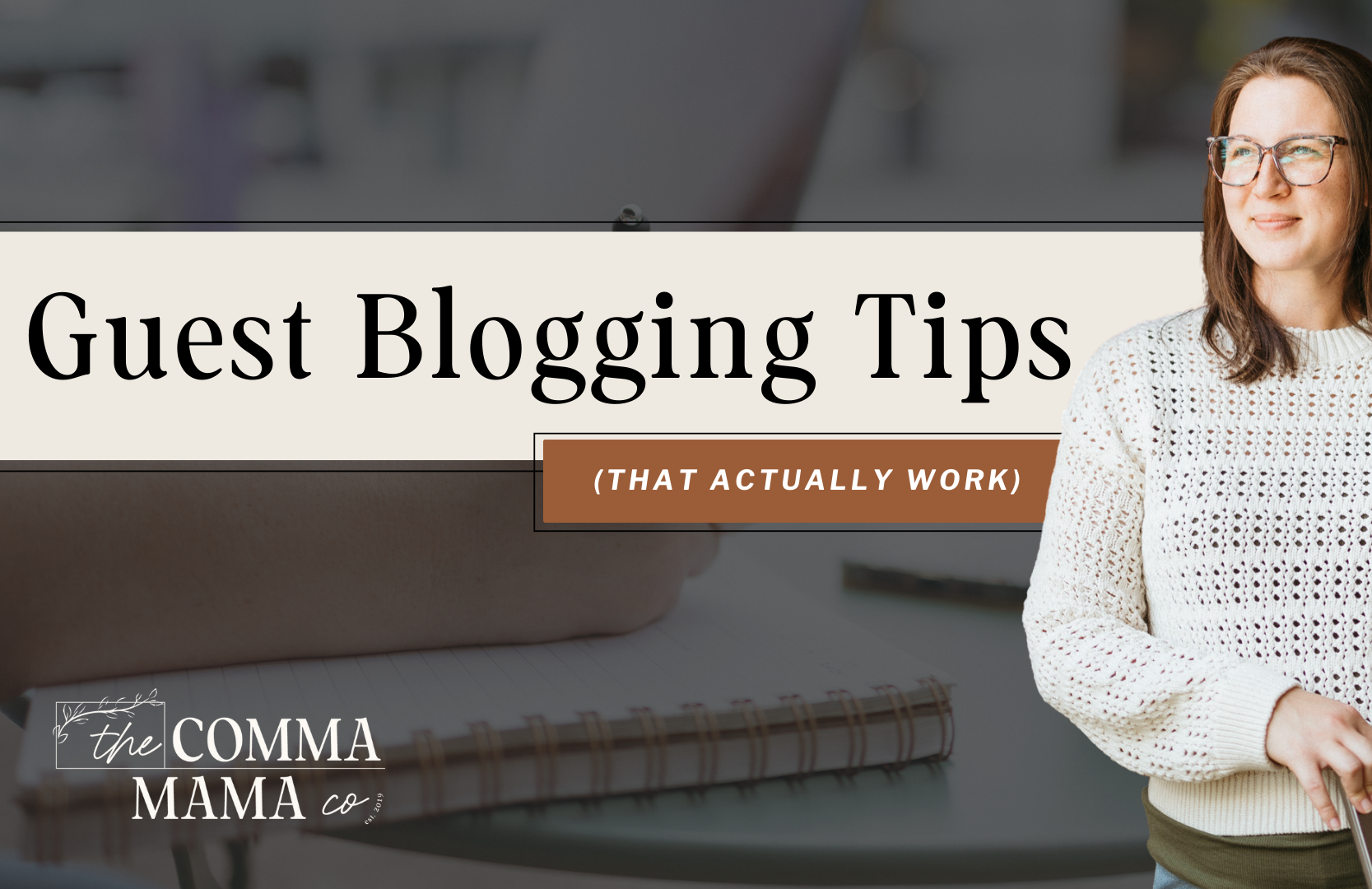I have a love for words and a knack for SEO – and as a mama, I know just how challenging it can be to run a business while raising a family. This blog is just one of the many resources you’ll find here that’ll help you boost your online visibility without sacrificing your sanity.
Thanks for being here (and I hope you’ll stick around).
Mckayla
categories
blogging
seo
Business
Six simple steps to better seo
download now
explore
case studies
to the shop
work with us
follow us on instagram
share
There are so many moving parts when you start blogging. Content planning, keyword research, blog post structure, backlinking, tags… All connected, but have a specific way to do or set up to help you reach your target audience. And while you should definitely check up on the best practices for all of them, we’re gonna focus on categories for now – specifically, the best blog categories for service providers.
Unlike traditional bloggers, lifestyle bloggers, or even the blogs of big businesses, as service providers, you won’t be producing the same amount – or same type – of content. While visibility is one of our goals, our main goal is to connect with our ideal clients when they’re ready to book or join the community.
Our goals are reflected in our content and therefore our categories. So, rather than having 10 or even 20 different categories, there are really only three blog categories for service providers that I recommend when starting a blog:
What Are Blog Post Categories?
Blog post categories or blog categories are how you can organize your website and allow your readers to navigate your content to find the information they want. A category is a high-level topic that includes multiple blog posts. Many bloggers like to think of their categories as a table of contents for their blog.
A blog post category should directly relate to the content you are publishing on your site. For example, if you’re publishing content that relates to marketing, your categories should likely revolve around marketing.

Every blog post should have at least one category assigned to it. If you don’t assign a category yourself, your blog post will default to ‘uncategorized.’ Still, you should never have more than two main categories (there are some exceptions for sub-categories) attached to a single blog post.
How Many Categories Should You Have on Your Blog?
Technically, there is no ‘ideal amount’ of blog post categories to have on your blog. Your categories should be determined by the blog posts you’re publishing and your niche. It’s also likely that your categories will expand over time, so while you may start with only three categories, you may have 10 in a year, or 150 in five years – or not.
It also depends on the type of business you run. For example, a photographer may have three main categories and then different categories for the cities they shoot in while a business coach may only have a few, maybe three or five even after a few years of blogging.
As you’re just starting your blog and publishing your first blog posts, keeping it simple is key. This is why you typically only need three main blog categories as a service provider.
Luckily, setting up blog post categories is pretty simple in most blog and website hosts. There are tons of resources online, but if you’re looking for help setting up your categories on showit, here’s a simple how-to you can use.
What Are The 3 Must-Have Blog Categories for Service Providers?

From years spent helping service providers plan and create content for their blogs, I’ve noticed a few common trends. There’s a specific type of content you should create for your blog first, and since Google loves content clusters, it’s best if your first batch of content relates to this topic. I love to refer to this topic as your main ‘non-negotiable.’
And remember, your blog categories should be short and sweet. Keep it to one to two words, three max! But, I won’t give it away in the intro, instead, let’s take a deep dive into the blog categories every service provider should have:
#1. Your Offer
This is the #1 non-negotiable I mentioned before, your offer. This is the first category you should create and the first content cluster you should write. And I want to get a little more specific, I mean what your offer refers to or results in. Here are some examples:
If you’re an Instagram Strategist, your first category might look like…
- Instagram Strategy
- Instagram Marketing
- Instagram Tips
Do some keyword research to find what would have the best chances of ranking, just keep in mind you don’t want to participate in keyword cannibalization and hurt your actual services page.
#2. Your Audience
This is the category that is directly connected to who you’re writing for – aka who you’re ideal client is. Are they moms? Families? Coaches? This category is to include the personable blog posts you should write that connect with your audience on a level deeper than ‘education.’ Here are some examples:
If you’re a Photographer who focuses on maternity photography and their ideal client is an expecting mom, their second category might look like…
- Motherhood
- Newborn Tips
- Tips for Expectant Mothers
- Pregnancy
They would then write blog posts such as “How to Boost Your Confidence During Pregnancy” or “XX Maternity Dresses for Summer.” Both tie into photography but connect a little more with their audience. That’s the goal of your second blog post category.
#3. Your Big Picture
If you’re giving general advice, what does it relate to? Entreprenurship? Finance? Marketing? That’s the goal of blog category three. It’s your catch-all for advice, tips, and everything in between that doesn’t fit into the other two and you don’t necessarily have enough to write to create a category for itself – or it doesn’t make sense to.
It should boil down to what is your overall topic. For example, a premier accounting and bookkeeping firm would be “Finance.” A social media manager would be “Marketing.” A good default blog post category for B2B service providers is “Business” and B2C would be “Lifestyle.”
Remember that you can branch off of your categories in the future, but for now, having this as one of your primary categories can make it so much easier to navigate as a reader.
How Do Blog Categories Impact Your SEO?
Blog categories add a hierarchy to your pages and essentially give Google a straightforward answer to what your blog post – and blog – are about. This allows Google to put your blog post where it needs to be in search to give the most value to its users.
Additionally, every blog category has its own ‘landing page’ that can be optimized and ranked on Google. Ranking pages on your website help your other pages get indexed and ranked.
Blog categories are just one of the many ways you can boost your SEO and improve your website’s performance and visibility as a service provider.
Once you’ve got your content and on-page SEO down, I highly recommend working on your off-page SEO. You can do so by working on building high-quality backlinks – you can get the complete guide here.
Hope you found this helpful (and you’re able to keep moving forward with your blog)! If you have any questions or comments, add them in the section below:
Pssstttt… Don’t forget to join us on January 11th @ 10 am EST for a free SEO masterclass for small business owners!

Reader Etiquette
© - Content and images in this blog are copyright this blog unless stated otherwise. Feel free to repost or share images for non-commercial purpose, but please make sure to link back to this website and its original post.
℗ - We do not store any information about your visit to our website other than for analytics and optimization for content and reading experience through the use of cookies.
c/o - Our site does at times contain paid advertisements, sponsored content, and/or affiliate links.
You might want to check these out too while you're at it
FREE Guide:
6 Simple Steps For Better SEO
INSTANTLY IMPROVE YOUR GOOGLE RANKING
Want to improve your website SEO in one afternoon? This free resource offers 6 actionable steps you can take in 15 minutes or less to instantly improve your SEO.
download now
categories
blogging
SEO
business
It's me, hi! Your SEO bestie.
get to know me
work with us
//
services
//
case studies
//
Mom of three, lover of all things blogging, and borderline obsessive coffee drinker — I also just happen to love making complicated things simple and accessible, especially when it comes to SEO. The blog is a collection of what I've learned from years of testing, trial and error, and working with amazing clients with impactful businesses (just like yours). Blogging and SEO doesn't have to be boring — and it definitely doesn't need to be difficult.



